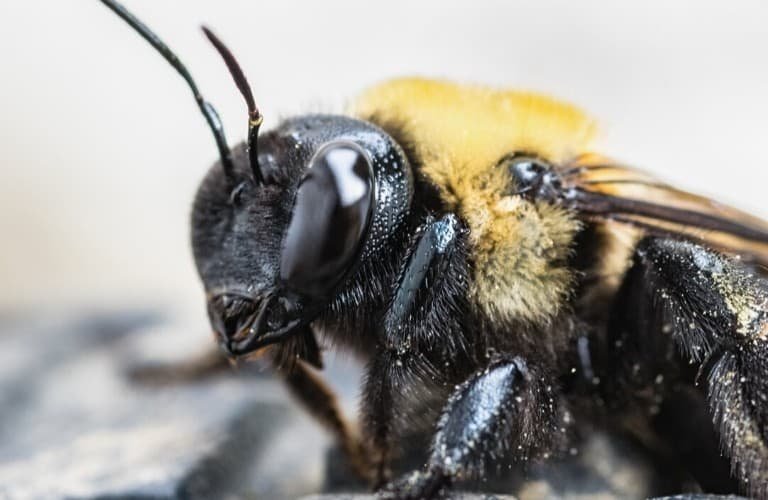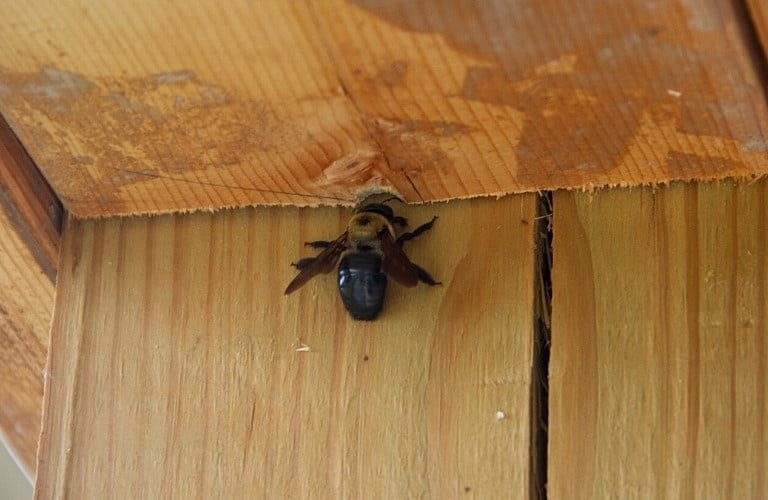The internet has mixed feelings about carpenter bees. Many pest control sites encourage exterminating them, while gardening websites firmly advocate against harming them.
It’s no wonder so many people are confused about these bulky bees.
Are carpenter bees good or bad? Carpenter bees can be a pest problem for homeowners, but they do more good than harm. They pollinate plants, which makes them grow, although they do tunnel and nest in wood and can cause damage to homes. They don’t swarm, however, and are nonaggressive.
If you’re thinking about getting rid of some carpenter bees, it’s important to carefully weigh the pros and cons of doing so before you take action.
In the following, you’ll learn about the important roles in nature that they fill and whether or not any destruction they may cause is truly reason for concern.
Good Things About Carpenter Bees
Carpenter bees do a lot of good in the world. Let’s take a look at some of the things they do.
Don’t miss out on important carpenter bee facts and prevention guidelines. Click here to learn more about protecting your property and the bees.
They Make Our Food
Not every plant requires bees to grow, but if it has seeds and you eat the fruit of the plant, then it requires bees.
This includes apples, onions, blueberries, almonds, and cucumbers, although there are many more foods that rely on bees.
Besides bees, plants rely on the following methods to get pollinated:
- Self-pollination.
- Wind.
- Birds.
- Other insects.
If you grow leafy or root vegetables from seed and you don’t want to harvest seeds for next year, you don’t need bees.
However, if you do want seeds to collect, you’ll need bees.
While home gardeners who rely on store-bought seed packets and don’t mind pollinating flowers themselves can get along without bees, humanity can’t continue without bees because it would stop seed production for all plants.
They Don’t Swarm
There’s no need to panic if you spot carpenter bees in your yard. You won’t cause them to become angry and form a swarm.
Carpenter bees are solitary, unlike bumblebees. Bumblebees live communally in nests and can swarm if they feel threatened.
Carpenter bees, on the other hand, live alone and won’t call on other bees to attack.
You might occasionally see a group of carpenter bees, and that’s because they sometimes like to live in small communities.
They’re more like neighbors than they are roommates, however. They live near each other, but they don’t share nests.
Did you know? Not all carpenter bees look alike. Many sport the classic yellow-and-black bee coloration, but some are all black, and others have brilliant blue markings (see the blue carpenter bee here)!
They’re Native to North America
Many people advocate for supporting local businesses. Well, local bees need support too.
Many farmers and commercial beekeepers import honey bees from other beekeepers because they make lots of honey, which in turn makes the beekeepers some money.
There’s nothing wrong with that since honey bees are important pollinators too, but they take away from native bees.
Carpenter bees are one of the 4,000 species that are native to North America.
Since honey bees are so heavily important and held in such high regard, native bees that look nothing like the honey bees get pushed to the wayside because they aren’t as recognizable as the imported honey makers.
Local bees are incredibly important for natural habitats to thrive. All the plants that are native to your area rely on local bees.
Imported honey bees tend to overlook native plants. If imported bees are the only option in your area, you might notice a decline in the usual variety of plants.
The carpenter bee population has been suffering in recent years, as is the case with many types of bees. Are they on the brink of being endangered? Find the answer here.
Bad Things About Carpenter Bees
Carpenter bees are known as pests for a reason. Homeowners might see them in a negative light because of the following problematic behaviors.
They Can Damage Wood
These solitary bees prefer to build their nests in wood.
They might use the trunk or branches of a tree or bushes, but they might decide to use your fence, siding, birdhouse, or whatever else that’s wood in your yard.
It’s annoying and invasive, and it could become a problem if you have small children who are afraid of flying insects.
The biggest issue is that they have to drill holes to make their nests. These holes are pretty small, however.
The entrance is usually about ¼ inch, although they can get up to ½ inch or maybe a little bigger.
These resourceful creatures will use holes created by other pests and turn them into their nest.
The inside of the nest measures at least 6 inches deep and might extend up to 1 foot long if they have the room to do so.
They don’t eat the wood, so that means they leave piles of sawdust behind.
It can be unsightly if you have a pristine patio, which is why many homeowners hate them so much.
The sawdust of one bee might not be much of an issue, but if you have a community of bees making use of wood, then it can become a pretty big problem.
You may have heard that WD-40 is an effective treatment for problematic carpenter bees. This article explains why it does indeed work.
It would have to take a lot of bees to cause structural damage to your home.
You don’t have to work quickly when you spot them because a few bees can’t really do enough damage in their lifetime.
But, if there have been several years of nesting taking place in your house or shed, then you might have some problems arise.
In this article, you’ll find several methods of safely luring carpenter bees away from structures to a more suitable location.
Females Have Stingers
The female bees are responsible for building nests and raising their young, so they’re equipped with a stinger to ward off threats.
The male bee that mated with the female will buzz around the nest entrance to protect the female and her brood.
If that male bee buzzes around your head, it’s simply to act tough to scare you off. You only need to be worried if the female comes out to take care of the predator herself.
As we mentioned before, the female bee won’t call other bees to fight with her.
The only reason you’d have multiple carpenter bees buzzing around and stinging you is if you threatened multiple bees (or at least gave them a reason to feel threatened). They won’t form an angry mob without a personal attack first. Carpenter bees are naturally non-aggressive. You could sit on the ground and observe their pollination process without getting harmed.
However, if you swat at them or disturb their nest, get ready to defend yourself.
How to Make a Bee Problem Benefit You
Weigh the pros and the cons before you make any decisions about getting rid of carpenter bees.
(If you do decide that there is no choice but to banish them from your property, we show you the steps to take here.)
Instead of removing or eliminating them, try to use them to your advantage.
Provide a Space for Bees
Create a bee habitat by creating a space in your yard with several places they can live in. They prefer untreated wood that’s at least 6 inches deep.
You can buy a bee house, make one yourself, or just use a post. You could make a birdhouse with a thick base so you can attract both birds and bees to your yard.
Most people, however, choose to purchase a premade bee house for simplicity’s sake.
This one with 96 nesting tubes for example, only requires you to hang it on a post or tree using the pre-installed mounting hooks.
The roof provides the bees with protection from inclement weather, and the replaceable paper liners for the tubes make the yearly upkeep super easy.
A proper bee space should have plenty of plants. Choose native species that are abundant in your area.
This will attract nearby bees and will keep them occupied since they like to stick with what they know most of the time.
Lastly, keep a supply of water in the space. It should be shallow – no deeper than water pooled up on a dinner plate.
You can use stones and pebbles to create places for bees to land in a dish of water or in a shallow birdbath, like this one that’s ideal for both birds and bees.
Plant a Vegetable Garden
Plant vegetables that grow lots of blossoms like tomatoes, cucumbers, or beans. Bees will flock to these, and this is how you turn a pest into an ally.
The more bees you have, the more likely you are to have a bountiful harvest.
The vegetable garden is a great place to put a bee house.
Many carpenter bees don’t like to travel too far from their nest, so making their food sources close to home will encourage them to stick around and will coax them away from your house.
Final Thoughts
The question, “Are bees good or bad?” will get different answers depending on whom you ask. Objectively speaking, they’re good because they pollinate plants.
Pollination is what allows plants to grow fruits and develop seeds. Without the fruits, humans can’t eat, and without the seeds, we’ll run out of food.





